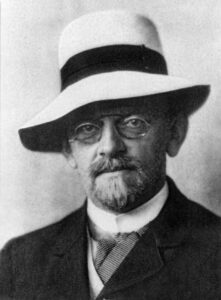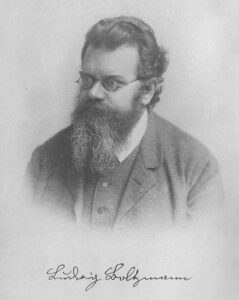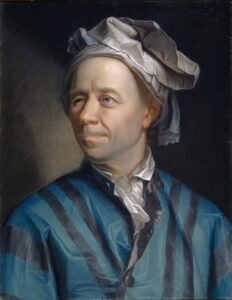
Basing their calculations on spherical particles of a gas, mathematicians have formed axioms that explain the physics of particle motion, beginning with the collision of a single particle pair, dispersing by kinetic energy to particular locations, and the combination of all particles in all locations acting as a gas in a closed system. The axioms are an answer to the 6th problem described by famed mathematician David Hilbert in his list of 23 fundamental problems issued 125 years ago. Image: The Quantum Record.
By James Myers
Did you ever wish you could go back in time to undo something you did? You would be a rare person if your answer is no, and the laws of physics guarantee you couldn’t reverse time in any event. But physical laws contain a paradox, because the laws of motion set out 350 years ago by Isaac Newton show that the past actions and future effects of colliding particles are equally predictable. This makes Newton’s equations of motion effectively reversible in time.

Professor of Mathematics Zaher Hani is one of three authors of a paper that answered David Hilbert’s 6th problem. Image: University of Michigan.
Now, mathematicians have unlocked a puzzle about time so major that it was number 6 on David Hilbert’s famous list of 23 fundamental questions that he put to fellow mathematicians 125 years ago. Specifically, Hilbert proposed “to treat in the same manner [as geometry], by means of axioms, those physical sciences in which mathematics plays an important part,” and a team of three mathematicians has now provided axioms for the physical motion of gases and gas particles.
A system of axioms is a series of logical statements, each one building on the former, that establish a foundational principle or self-evident truth. In a series of papers, Yu Deng, Zahir Hani, and Xiao Ma have provided an axiomatic answer to Hilbert’s 6th problem. The implications are paradigm-shifting, because the discovery demonstrates the mathematical connection between time-reversible equations of physical motion and the irreversibility of time as we experience it in three dimensions of space.
To reach their conclusion, Deng, Hani, and Ma considered the behaviour of spherically-shaped gas particles in a rectangular container. Beginning with collisions between individual particles, next they considered the particles’ behaviour in combination as a gas where it’s possible to predict numbers and speeds of particles at a particular location. Finally, they accounted for the physical equations that describe how the gas as a whole operates at all locations. The results were published in their May 2025 paper, Hilbert’s sixth problem: derivation of fluid equations via Boltzmann’s kinetic theory.
- David Hilbert
- Isaac Newton
- Ludwig Boltzmann
- Claude-Louis Navier
- George Stokes
- Leonhard Euler
Although there was no doubt that sequences of motion in gases are connected, physicists have had to use three types of equations to explain them. Newton’s equations explain individual particle collisions at the microscopic level, and at the intermediate mesoscopic level the Boltzmann equation explains the likely behaviour of particle combinations at a particular point in space and time. Finally, the equations of Navier-Stokes and Euler describe the actions of a gas at any point in space and time. The work of Deng, Hani, and Ma unifies the three-equation approach for physical motion in a set of mathematical axioms.

Figure 1 from Hilbert’s Sixth Problem: derivation of fluid equations via Boltzmann’s kinetic theory illustrates the limits of motion from microscopic to macroscopic levels.
To crack the mystery of Hilbert’s 6th problem, the mathematicians used a key assumption of physicist Ludwig Boltzmann (1844-1906), whose equation of kinetic action operates at the mesoscopic level. Boltzmann’s equation works with gas particles that operate essentially independently, with the same pair of particles very rarely colliding multiple times. The researchers then built on a ground-breaking discovery in 1975 by mathematician Oscar Lanford, who demonstrated the rarity of collisions between multiple pairs of spherical particles– but only for a very short time.

Oscar Lanford, 1940-2013. Image: Harvard University
Boltzmann’s equation was a key ingredient for Hilbert’s 6th problem. As Hilbert himself stated, “…Boltzmann’s work on the principles of mechanics suggests the problem of developing mathematically the limiting processes, there merely indicated, which lead from the atomistic view to the laws of motion of continua.” (Continua is the plural of continuum, which is something that has no limit because it continues forever in time).
The challenge was to extend Lanford’s discovery to arbitrarily long periods of time, completing the mathematical chain for physical motion—from microscopic to mesoscopic to macroscopic—over time. That’s because the details of the step from mesoscopic to macroscopic had already been established for a scenario in which boxed-in spherical gas particles collide with one face of the box and reappear on the opposite face.
Geometry provided one of the keys to expressing the mathematical axioms. The researchers were able to derive the Boltzmann equation by placing Newton’s spherical gas particles on a two-dimensional torus to map and calculate the probable scatterings of their elastic collisions. A torus is a doughnut-shaped geometric object with the important property that lines on it never cross more than once. On the same torus, they put the particles in an equilibrium and established the axioms for the Navier-Stokes equation, with changes that translate regularly in space according to the mathematics of Joseph Fourier (1768-1830).

A torus is a doughnut-shaped geometric object. This image of a torus shows various rings around its surface. Image by Tilman Piesk, from Wikipedia.
To complete the axioms by deriving the Euler equation, on the same torus they put the particles in motion with iterative limits, where the number of particles in each repetition goes from two to infinity and their spherical diameter goes from maximum to zero. Named after famed mathematician Leonhard Euler (1707-1783), the Euler equation applies to a compressible gas that reduces from a large diameter to two particles that share the same minimum radius, whereas the Navier-Stokes equations apply to incompressible gases that exist only at one specific diameter.
In the course of their derivations, the mathematicians developed a new algorithm for the desired structure of elementary molecules, which are the building blocks for physical matter. This provided them a way to use simpler versions of complex patterns to derive a mathematically global pattern much more efficiently.
What major discoveries will the mathematical axioms of physical motion enable?
The work of Deng, Hani, and Ma provides the mathematical tools to describe cause-and-effect connections among gas particles, from their initial interactions to their large-scale behaviour as a collective gas. While mathematics and physics communities begin to work out possible applications for the newly discovered axioms, consideration is being given to developing tests for realistic situations. Such tests could determine, for example, how gas particles of different geometric shapes would behave in more complex interactions.
It may be possible that the mathematical axioms will lead to new discoveries in dynamic processes and in thermodynamics, the second law of which establishes that heat generated by the interactions of material particles naturally diffuses from hot to cold in a process now generally called entropy. Entropy is the tendency of physical matter – essentially, collections of individual particles – to disintegrate by interaction over time, moving from a state of maximum order, or coherence, to a state of maximum disorder, or decoherence.

Imagine graphing particle interconnections, with entropy gradually diffusing the original connections among a vast array of subsequent connections that evolve over time. Image by Conny Schneider, on Unsplash.
As a result, the second law of thermodynamics – which is a bedrock principle in physics – more broadly says that physical time moves in only one direction. While the first law of thermodynamics says that energy is universally conserved, never disappearing but instead moving from one location to another, the second law places a single directional restriction on energy’s motion.

Geometry is a key to quantum computing. In the quantum computer, information transfers between quantum bits called “qubits”. The quantum is the smallest amount of energy in the universe that can exist as either the cause or the effect of a change in physical mass. The quantum is geometrically represented as a sphere (shown above), which comprises a full range of probabilities between two limits that are labelled 1 and 0. The quantum computer “reads” combinations of probabilities among qubits.
The new mathematical axioms could provide greater insight into the mechanisms underlying the geometry of motion. Geometry is the science of shape and connections, and the axioms describe, in numbers, the evolution of connections among gas particles in motion. The geometry of the particles is key to the outcomes of their collisions, and while the axioms apply to particles with a spherical shape, other particle geometries would produce different patterns of connections.
The axioms might also help in the search for thermodynamic principles at the fundamental level of the quantum, which is the smallest unit of energy that can act as either a cause or effect of physical change.
Gases yield important information about physical matter.
The quest for knowledge about gas behaviour continues to provide profound insights into the operation of physical matter, and the insights continue to deliver remarkable technologies.
The work of Deng, Hani, and Ma continues in the tradition of ground-breaking insights of many prominent scientists, including most famously Albert Einstein. Although Einstein could have received a Nobel Prize for his Theory of General Relativity, because it has enabled much of the technology that now shapes our daily lives, instead he was awarded the prize for his earlier work on “Brownian” motion of particles.
Brownian motion is the apparently random motion of particles suspended in a medium of liquid or gas and operating in an enclosed space. Einstein’s Nobel Prize insight was to connect, mathematically, the probability of a Brownian particle being in a particular space to equations for the diffusion of particles over space. Einstein went on, in 1905 and again in 1915, to establish the relativity of particle masses to energy with his famous equation E=mc2 that says energy translates to mass at the rate of the square of lightspeed. The speed of light, which is denoted by the letter c in Einstein’s equation, is the universal limit for the diffusion of energy in space and time.
Will another insight about particle motion, in a similar tradition, lead to discoveries even more amazing than GPS, mobile phones, internet, satellites, and nuclear reactors that Einstein’s Theory of General Relativity has already enabled? Maybe, 110 years after General Relativity was introduced, we are on the cusp of another technological revolution sparked by a deeper understanding of the geometry and mathematics of gas behaviour.
Further information on the mathematical discovery by Deng, Hani, and Ma is freely available in Quanta Magazine, which was an important source for this article.











